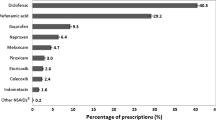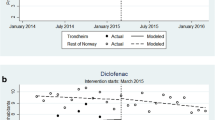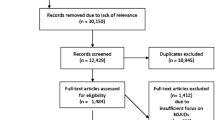Abstract
Objective. We compared the utilisation pattern and cost of non-steroidal anti-inflammatory drugs (NSAIDs) in Rijeka, Croatia and in Stockholm, Sweden using a newly introduced method for assessing the quality of drug use, i.e. to determine the number of drugs that account for 90% of the use and the adherence to evidence-based recommendations within this segment (the DU90% methodology).
Methods. We analysed prescription NSAIDs dispensed during the first 6 months of 2000 in Rijeka and in Stockholm and recorded number of prescriptions, number of defined daily doses (DDDs), number of DDDs/1000 inhabitants per day and percentages and determined the DU90% segment by substance and brand name. Within the DU90% segment we determined the proportion of NSAIDs associated with high (ketoprofen, piroxicam) and low (ibuprofen, diclofenac) risk for gastrointestinal (GI) toxicity according to a meta-analysis of controlled epidemiological studies. We also compared the cost for NSAIDs in both regions as well as the cost for each NSAID expressed in Euros.
Results. In Stockholm the utilisation of NSAIDs was twofold greater than in Rijeka (28.6 DDDs/1000 inhabitants/day vs 14.2 DDDs/1000 inhabitants/day). Within the DU90% segment we found four NSAIDs (of nine) in Rijeka and 16 (of 37) in Stockholm. In both regions diclofenac was the most commonly prescribed substance (55% in Rijeka and 25% in Stockholm). Diclofenac was also the cheapest drug in Rijeka. In Stockholm, the most commonly prescribed single brand drug was rofecoxib, a cyclooxygenase-2 inhibitor with a price far above the old NSAIDs. A significant proportion of "high GI risk" NSAIDs was found within the DU90% segment both in Rijeka (piroxicam, 23%) and in Stockholm (ketoprofen, 14%). Although the gross national product was five times higher in Sweden than in Croatia during 2000, on average, NSAIDs were three times more expensive in Sweden than in Croatia (0.52 Euros/DDD vs 0.18 Euros/DDD). Ibuprofen (DDD 1200 mg), the safest drug regarding GI toxicity, was not the most prescribed in either region.
Conclusion. Our study suggests that evidence-based medicine was not the leading impact factor in prescribing NSAIDs during 2000. A proportionally higher use of ibuprofen (at a daily dose of 1200 mg) and a reduced use of either piroxicam or ketoprofen would improve the NSAID GI safety profile in both countries. As previously shown for Sweden and some other countries, the DU90% methodology was found to be a useful method for assessing the general quality of NSAID prescribing in Croatia.
Similar content being viewed by others
Author information
Authors and Affiliations
Additional information
Accepted in revised form: 28 January 2002
Electronic Publication
Rights and permissions
About this article
Cite this article
Vlahovic-Palcevski, V., Wettermark, B. & Bergman, U. Quality of non-steroidal anti-inflammatory drug prescribing in Croatia (Rijeka) and Sweden (Stockholm). Eur J Clin Pharmacol 58, 209–214 (2002). https://doi.org/10.1007/s00228-002-0449-2
Received:
Published:
Issue Date:
DOI: https://doi.org/10.1007/s00228-002-0449-2




